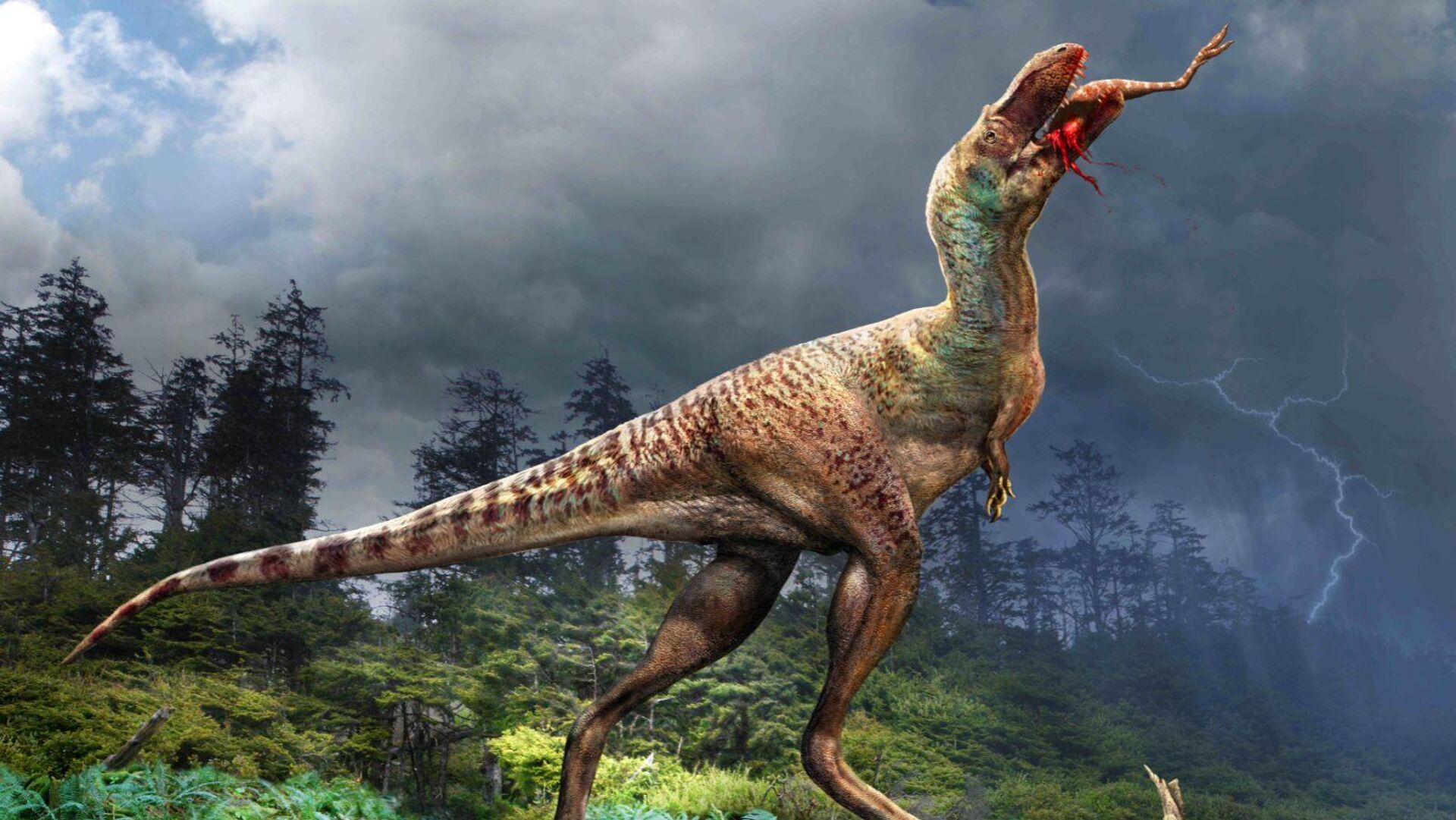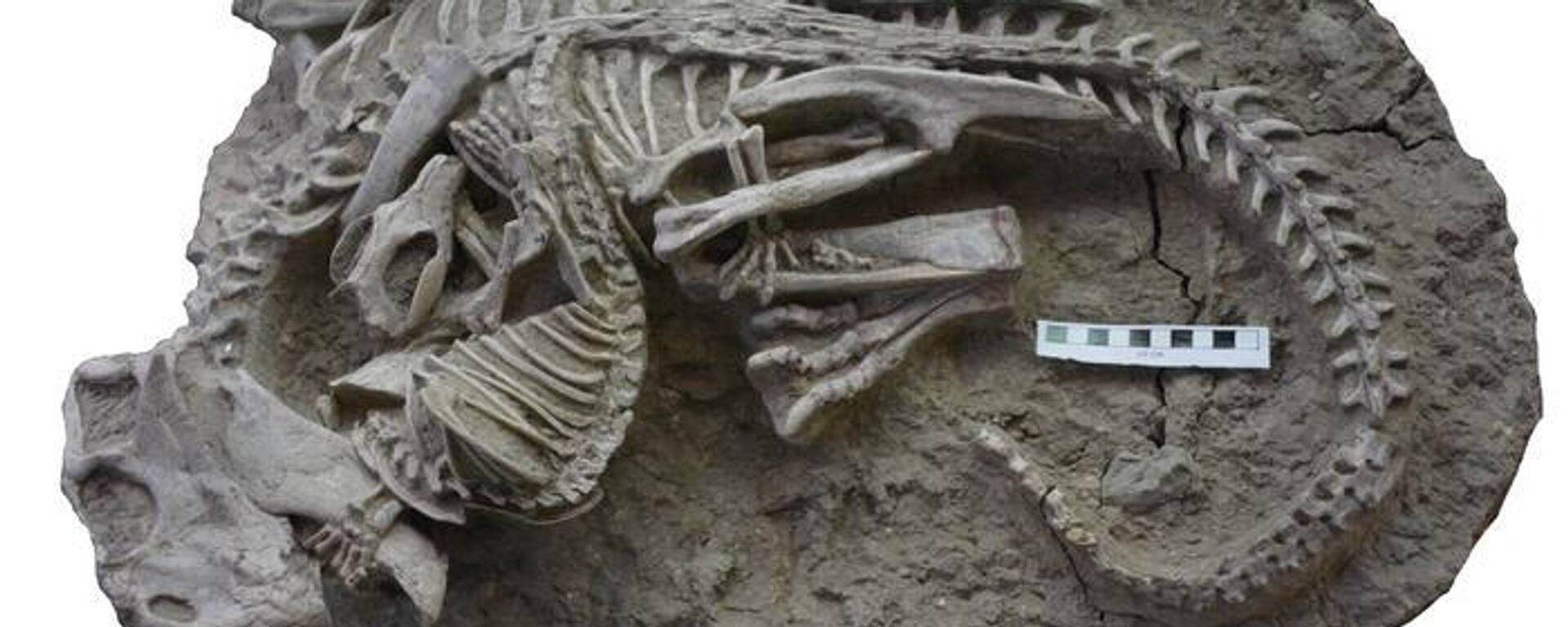https://en.sputniknews.africa/20231209/prehistoric-diet-scientists-find-out-what-was-on-menu-for-young-tyrannosaurids-1064040444.html
Prehistoric Diet: Scientists Find Out What Was on Menu for Young Tyrannosaurus
Prehistoric Diet: Scientists Find Out What Was on Menu for Young Tyrannosaurus
Sputnik Africa
In 2009, Canadian paleontologists discovered the remains of Gorgosaurus libratus, a tyrannosaurid that lived in western North America about 84-66 million years... 09.12.2023, Sputnik Africa
2023-12-09T16:57+0100
2023-12-09T16:57+0100
2023-12-09T17:48+0100
international
science
canada
dinosaurs
lifestyle
food
history
https://cdn1.img.sputniknews.africa/img/07e7/0c/09/1064041117_0:0:1601:901_1920x0_80_0_0_e61053418ebcda6a72594fa316251426.jpg
What did the young tyrannosaurs eat? A new discovery by scientists at the University of Calgary in Alberta, Canada, has answered this question.The discovery was facilitated by the well-preserved remains of Gorgosaurus, which was found to have died between five and seven years old and weighed approximately 334 kilograms.When the skeleton was examined in the lab, it turned out that among the predator's bones were the bones of its last meal, two specimens of bird-like dinosaurs, known as Citipes.According to paleontologists, Gorgosaurus was a selective predator, as it limited itself to biting off and swallowing only the shins of its victims without finishing the whole prey.The discovery allowed scientists to better understand how the diet of tyrannosaurids changed with age. Experts believed that the young lizards hunted relatively small and agile prey, such as Citipes. But by age 11, their bodies grew to about 10 meters and weighed more than three tons, after which the giants switched to giant herbivorous dinosaurs.According to paleontologists, such a diet allowed young tyrannosaurids to coexist with adults in a single ecosystem without conflict over prey.The researchers added that such drastic dietary changes are not uncommon in the animal kingdom, with crocodiles and Komodo dragons eating insects before moving on to rodents and eventually large mammals.
https://en.sputniknews.africa/20231001/1062461524.html
canada
Sputnik Africa
feedback@sputniknews.com
+74956456601
MIA „Rossiya Segodnya“
2023
Maxim Grishenkin
https://cdn1.img.sputniknews.africa/img/07e7/0a/17/1063018107_0:0:1104:1103_100x100_80_0_0_03090c85a11f5d2e8a19cf1d989443c9.jpg
Maxim Grishenkin
https://cdn1.img.sputniknews.africa/img/07e7/0a/17/1063018107_0:0:1104:1103_100x100_80_0_0_03090c85a11f5d2e8a19cf1d989443c9.jpg
News
en_EN
Sputnik Africa
feedback@sputniknews.com
+74956456601
MIA „Rossiya Segodnya“
Sputnik Africa
feedback@sputniknews.com
+74956456601
MIA „Rossiya Segodnya“
Maxim Grishenkin
https://cdn1.img.sputniknews.africa/img/07e7/0a/17/1063018107_0:0:1104:1103_100x100_80_0_0_03090c85a11f5d2e8a19cf1d989443c9.jpg
international, science, canada, dinosaurs, lifestyle, food, history
international, science, canada, dinosaurs, lifestyle, food, history
Prehistoric Diet: Scientists Find Out What Was on Menu for Young Tyrannosaurus
16:57 09.12.2023 (Updated: 17:48 09.12.2023) In 2009, Canadian paleontologists discovered the remains of Gorgosaurus libratus, a tyrannosaurid that lived in western North America about 84-66 million years ago. What made the discovery unique was that the contents of the tyrannosaur's stomach were discovered for the first time in history.
What did the young tyrannosaurs eat? A new
discovery by scientists at the University of Calgary in Alberta, Canada, has answered this question.
The discovery was facilitated by the well-preserved remains of Gorgosaurus, which was found to have died between five and seven years old and weighed approximately 334 kilograms.
When the skeleton was examined in the lab, it turned out that among the predator's bones were the bones of its last meal, two specimens of bird-like
dinosaurs, known as
Citipes.
According to paleontologists, Gorgosaurus was a selective predator, as it limited itself to biting off and swallowing only the shins of its victims without finishing the whole prey.
"It must have killed […] both of these Citipes at different times and then ripped off the hind legs and ate those and left the rest of the carcasses," the research read. "Obviously this teenager had an appetite for drumsticks."
The discovery allowed scientists to better understand how the diet of tyrannosaurids changed with age. Experts believed that the young lizards
hunted relatively small and agile prey, such as Citipes
. But by age 11, their bodies grew to about 10 meters and weighed more than three tons, after which the giants switched to giant herbivorous dinosaurs.
"This study shows us that tyrannosaurs occupied various ecological niches during their lifespan," the researchers said. "They dominated the niche of mesopredators [mid-size predators] when they were young and then transitioned to apex or top predators as they grew. That is probably the reason why tyrannosaurs were so successful and dominated their ecosystems at the end of the Cretaceous in North America and Asia."
According to paleontologists, such a diet allowed young tyrannosaurids to coexist with adults in a single ecosystem without conflict over prey.
The
researchers added that such drastic dietary changes are not uncommon in the animal kingdom, with crocodiles and Komodo dragons eating insects before moving on to rodents and eventually large mammals.



